Who was Egon?

 A creative artist
A creative artistAn author of
specialized books

 A painting
A paintingphilosopher
The creator of
a foundation
Foreword
The first son of very extraordinary parents (a musician and a writer) found his avocation early in painting to which he was completely dedicated for 70 years. After his father freed himself from social constraints after 15 generations of recorded ancestors, this son in the next generation followed this example and consistently pursued his own somewhat lonely path as an artist while making some important discoveries. Egon's high and meditative ability to concentrate was an immanent part of his method of work. On the one hand he vividly was interested in what happened in the world and read world literature; on the other hand he had to shield himself from distractions to quietly execute his enormous opus. Thus he became somewhat isolated. He espoused conservative values and was philosophically inclined but stayed a sensual and energetic outsider with some blind spots and contradictions. His fourth wife called him a "monolith" who filled an entire room with his powerful present.
The first son of very extraordinary parents (a musician and a writer) found his avocation early in painting to which he was completely dedicated for 70 years. After his father freed himself from social constraints after 15 generations of recorded ancestors, this son in the next generation followed this example and consistently pursued his own somewhat lonely path as an artist while making some important discoveries. Egon's high and meditative ability to concentrate was an immanent part of his method of work. On the one hand he vividly was interested in what happened in the world and read world literature; on the other hand he had to shield himself from distractions to quietly execute his enormous opus. Thus he became somewhat isolated. He espoused conservative values and was philosophically inclined but stayed a sensual and energetic outsider with some blind spots and contradictions. His fourth wife called him a "monolith" who filled an entire room with his powerful present.
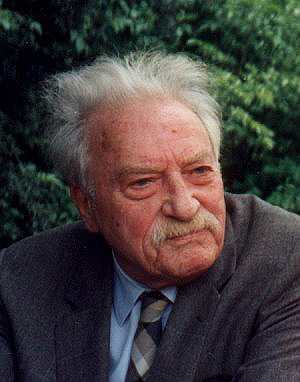 Was Egon von Vietinghoff a Dutch Master? No!
Was Egon von Vietinghoff a Dutch Master? No! He was a European painter who reestablished the Old Dutch and Flemish painting technique through 35(!) years of experimentation. He rediscovered its special creative possibilities for his own artistic expression and applied it brilliantly to his work.
Egon von Vietinghoff left a vast opus of 2.750 paintings and two written works (both available in German only):
the Handbuch zur Technik der Malerei, a primarily practical handbook of painting technique and the more theoretical philosophical manuscript Das Wesen der bildenden Kunst (The Nature of Visual Arts) dealing with the School of Pure Vision and the Transcendental Painting.
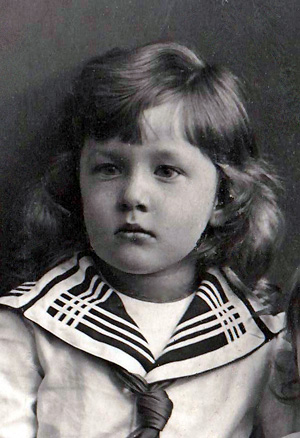 The Hague, Netherlands, the place of his birth, was an international crossroads of conservative and liberal forces, of the worlds of society and fine arts. The year of his birth was exactly midway between the two peace conferences held in The Hague (1899 and 1907), marking the radical political, social and cultural changes occurring in the late 19th and the early 20th centuries. These different energies decisively influenced and determined the life of Egon von Vietinghoff.
The Hague, Netherlands, the place of his birth, was an international crossroads of conservative and liberal forces, of the worlds of society and fine arts. The year of his birth was exactly midway between the two peace conferences held in The Hague (1899 and 1907), marking the radical political, social and cultural changes occurring in the late 19th and the early 20th centuries. These different energies decisively influenced and determined the life of Egon von Vietinghoff. Egon's childhood was not only marked by frequent moves and the consequences of World War I, but also by the strong effects of the artistic atmosphere reigning in his parents' house, where prominent guests from all over Europe were welcomed. His father was an extraordinary pianist and his mother was an author with an remarkably charismatic personality.
(see subchapter Jeanne von Vietinghoff resp. Conrad von Vietinghoff).
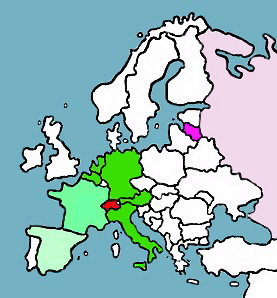 Egon von Vietinghoff rightfully saw himself as a European.
Egon von Vietinghoff rightfully saw himself as a European.His ancestors were German, Belgian, and Dutch. He lived in France, Germany, Italy, Spain, and Switzerland, and he fluently spoke the languages of these countries – as well as some English and Flemish. At age 19, he was granted Swiss citizenship, as he was a Russian subject at birth and thus became stateless upon the collapse of the Czarist Empire. He married four women originating from four different European countries! Consequently, he communicated with his parents, wives, children and grandchildren in four different languages.
(The marked countries on the map are the more or less important countries in Egon's life: Latvia, Russia, The Netherlands, Belgium, Germany, Switzerland, Austria, Italy, France, and Spain. In addition: Argentina and Uruguay. Pink shows his paternal origin, red his lifelong citizenship and main place of artistic creation.)
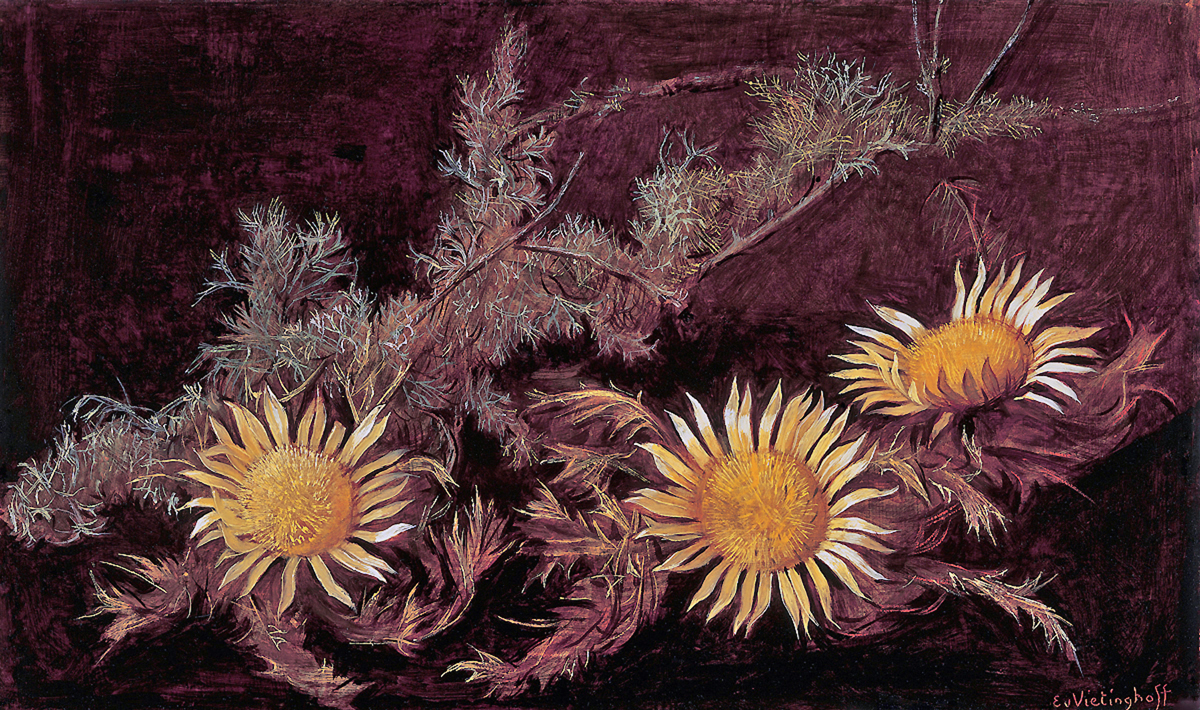 However, Egon von Vietinghoff found his true homeland in art at an early age. He was self-taught.
However, Egon von Vietinghoff found his true homeland in art at an early age. He was self-taught.When preparing his own paints from the purest (natural when possible) products available, he was a uniquely specialized craftsman. In his unswerving approach to the Transcendental Painting formulated by himself, he was a solitary creative artist. Transcendent experiences and the interior certainty of an invisible world, in which he had a part, were both source and support of his inspiration and his unerring judgment of art.
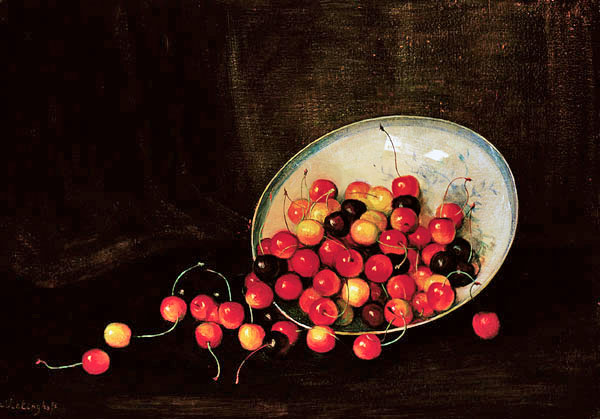 As many before him, as well as his contemporaries, he sought a way out of the artistic crisis of his time. He agreed with most of his painter colleagues, who later became famous due to their "modern" way of painting, that naturalism and impressionism were dead-end roads. But instead of moving towards abstraction, he came to the opposite conclusion and remembered the importance of the long-lost painting technique of the Old Masters.
As many before him, as well as his contemporaries, he sought a way out of the artistic crisis of his time. He agreed with most of his painter colleagues, who later became famous due to their "modern" way of painting, that naturalism and impressionism were dead-end roads. But instead of moving towards abstraction, he came to the opposite conclusion and remembered the importance of the long-lost painting technique of the Old Masters. Through meticulous self-studies, he rediscovered the lost skill of multilayer oil-resin painting. By reviving this tradition, he developed a unique mastery of this technique and proved the timeless value of these techniques for future generations. He devoted himself to maintaining the continuity of the traditional art of painting as a specifically European cultural heritage.
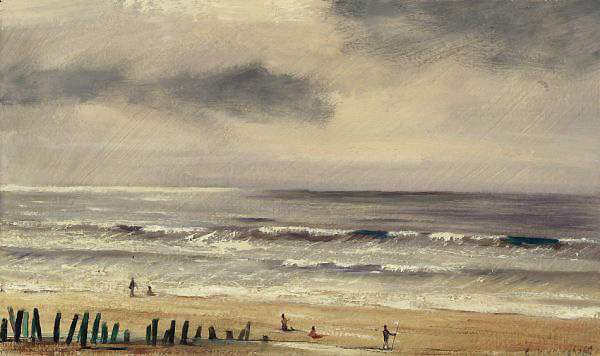 And this in the twentieth century when the history of art was marked by provocative changes in the current artistic style and by making art a political statement! By keeping his distance from these tendencies and following his own meditative way, he was as provocative as other contemporaries, but did not fit into the current trends. He was therefore disregarded or even consciously ignored by art dealers and critics. Over the course of time, he nevertheless succeeded in leading a financially independent life for his family – due in no small part to sales to private patrons.
And this in the twentieth century when the history of art was marked by provocative changes in the current artistic style and by making art a political statement! By keeping his distance from these tendencies and following his own meditative way, he was as provocative as other contemporaries, but did not fit into the current trends. He was therefore disregarded or even consciously ignored by art dealers and critics. Over the course of time, he nevertheless succeeded in leading a financially independent life for his family – due in no small part to sales to private patrons. 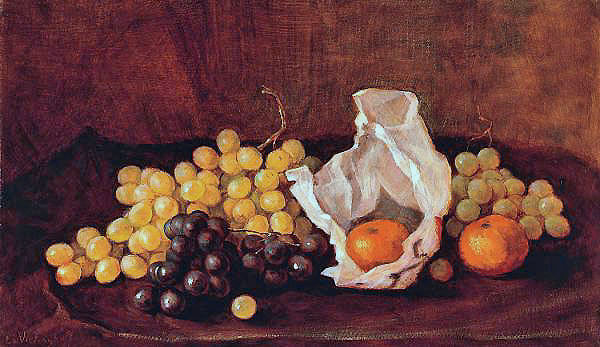 While in his earlier years he enjoyed sports and hosted boisterous studio parties, he settled down in the second half of his life, retired from social life and lived without personal pretensions. All his energy was now turned towards his artistic vocation – he painted with admirable discipline and intensity. His tremendous creative urge and his artistic idealism manifested themselves in an inspired life of 70 artistically active years full of struggle, creation and revelation. Up to the last year of his life, he devoured world literature, took pronounced positions in politics and economics, and wrote humorous poems.
While in his earlier years he enjoyed sports and hosted boisterous studio parties, he settled down in the second half of his life, retired from social life and lived without personal pretensions. All his energy was now turned towards his artistic vocation – he painted with admirable discipline and intensity. His tremendous creative urge and his artistic idealism manifested themselves in an inspired life of 70 artistically active years full of struggle, creation and revelation. Up to the last year of his life, he devoured world literature, took pronounced positions in politics and economics, and wrote humorous poems. 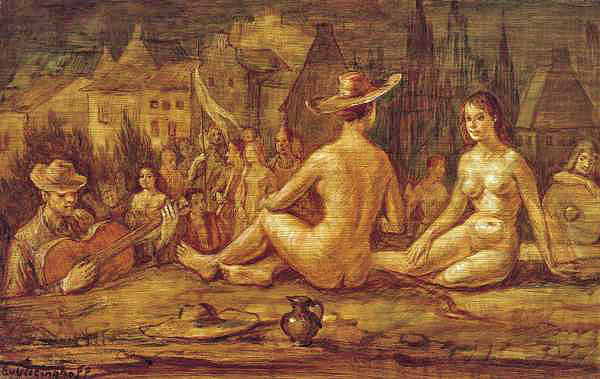 To overcome the fact that he is not represented in any museum, he created a foundation possessing a collection of his paintings in his late years.
To overcome the fact that he is not represented in any museum, he created a foundation possessing a collection of his paintings in his late years. The Egon von Vietinghoff Foundation's aim is to promote the legacy of Transcendental Painting and to make his work as an artist accessible to the public (see chapter Foundation).